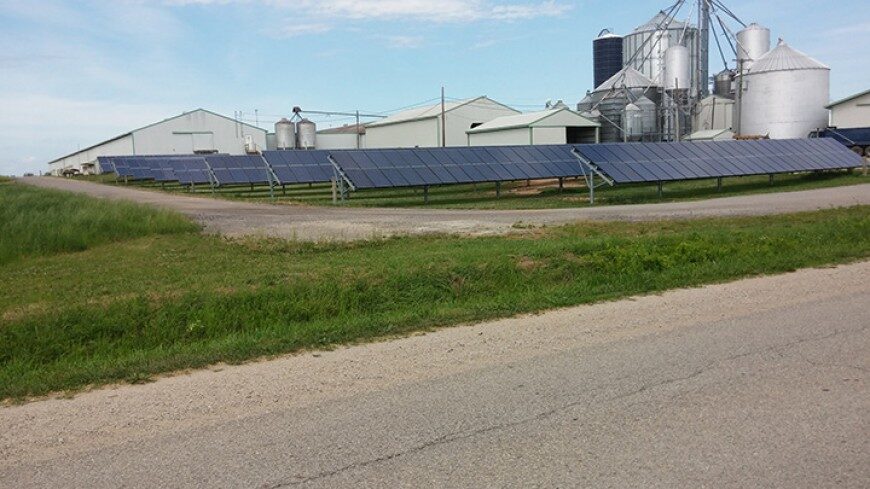
Langeland Farms SES. Photo by M. Charles Gould.
As Michigan utilities look to meet clean energy regulations and transition to renewables, a new guide is available to help communities across the state address solar-energy-system, or SES, siting within their planning policies and zoning regulations.
More Info
Download the guide: Planning & Zoning for Solar Energy Systems: A Guide for Michigan Local Governments
“The majority of zoning ordinances in the state are silent about solar energy systems,” said Sarah Mills, senior project manager at the University of Michigan’s Graham Sustainability Institute, who co-authored the report. “That can introduce a lot of uncertainty for residents who want to put solar panels on the roof or in their backyard, and also for owners of larger tracts of land who might wish to host a solar farm on their property.”
The guide, “Planning and Zoning for Solar Energy Systems: A Guide for Michigan Local Governments,” illustrates how various scales and configurations of photovoltaic SES fit into landscape patterns ranging from rural to suburban to urban, equipping communities to make informed public policy decisions related to solar energy development.
“We’re aiming to provide local governments with both an outline for including regulations in their zoning ordinance and commentary to think through how to customize ordinances based on that community’s existing goals and ordinance structure,” Mills said.
Tailored to Michigan, the guide is written with local planners, officials, legal counsel and policymakers in mind. It explains the current context of solar energy in Michigan, along with the various components and configurations of SES. It also offers principles around how SES might fit within various land-use patterns across the state and presents sample zoning-ordinance language.
“In our work with communities, we’ve come to recognize that those without zoning for renewable energy are at a distinct and worsening disadvantage,” said Brad Neumann, senior extension educator at Michigan State University Extension, who co-authored the report. “Zoning allows communities to choose proactively the role of renewable energy developments. Without it, communities increasingly find themselves reacting to individual proposals from developers instead of thinking big-picture about the vision for their future.”
The guide was developed by experts within MSU Extension and the MSU School of Planning, Design and Construction, in partnership with U-M’s Graham Sustainability Institute. Further review was completed by content experts from local units of government, legal counsel, energy-related nonprofits, utility experts and members of academia.
“Solar energy is a technology that’s possible in rural, suburban and urban communities and at all sorts of sizes: from rooftop solar installations to power a single home to thousand-acre solar farms that produce enough electricity to power tens of thousands of homes,” Mills said. “Our goal is to provide communities with the framework they need to think about it comprehensively.”
Master planning and preparing zoning ordinances are two important steps a community can take to become solar-ready. Additional steps include, among others, conducting meaningful public engagement, clarifying building and electrical permitting processes, reducing permit fees, and evaluating placement of SES on or near municipal buildings. Information on these aspects of planning for SES is available through the state’s SolSmart program and numerous Michigan agencies, universities and organizations.
“EGLE is pleased to support this important work on zoning for solar energy,” said Julie Staveland, sustainability section manager at Michigan Department of Environment, Great Lakes, and Energy. “Our state has aggressive goals to fight climate change, for the good of our citizens and our environment. Through this guide and other EGLE resources, the state works to level the playing field for all municipalities and empower local governments of all sizes to advance decarbonization in their communities.”
The MI Healthy Climate Plan, issued by Michigan Gov. Gretchen Whitmer in September 2020, outlines the state’s efforts to achieve carbon neutrality by 2050. Decarbonizing the electricity sector is a key component. Thanks to the rapid decline in the cost of solar energy over the past decade, solar is now the most quickly growing renewable, including at utility scale.
“We know electric utilities are pursuing more renewable sources of generation,” Neumann said. “On top of that, specific sectors of our economy are rapidly moving towards electrification, like the transportation sector, and solar energy systems will become increasingly used for home charging and at places of business for electric vehicles.
“For these reasons, ‘Planning and Zoning for Solar Energy Systems: A Guide for Michigan Local Governments’ will be a helpful resource for almost all local governments—from the most rural where our dual-use concept likely applies, to more urban communities where installation of rooftop solar energy systems will modify the skyline.”


